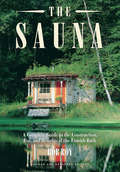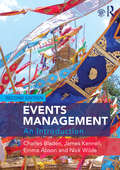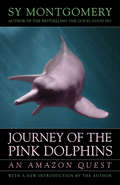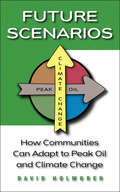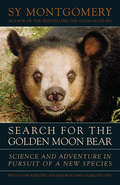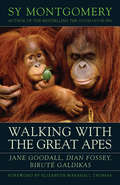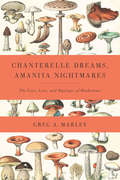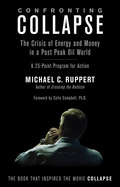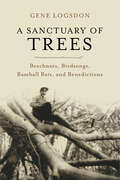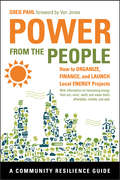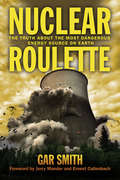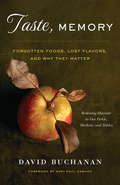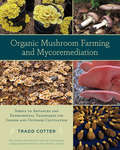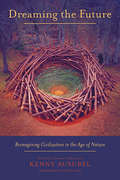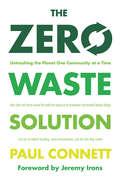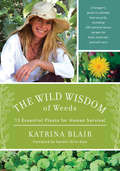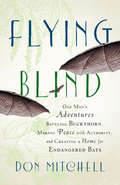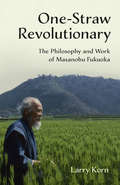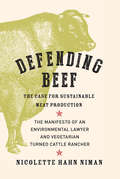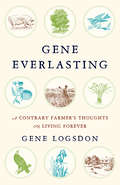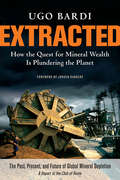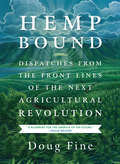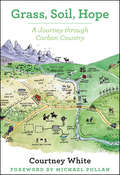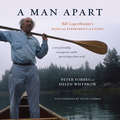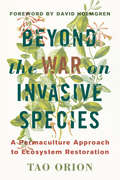- Table View
- List View
The Sauna: A Complete Guide to the Construction, Use, and Benefits of the Finnish Bath, 2nd Edition (Slow Food City Guides)
by Robert L. RoyWith a history going back at least one thousand years, the sauna is ready for a new generation of enthusiasts seeking health, pleasure, and peace of mind, and Rob Roy is ready to recruit! "If the sauna is just a bath, then Buckingham Palace is just a house." So writes sauna expert and intrepid do-it-yourselfer Roy in this new, updated version of The Sauna. This completely revised and expanded edition of The Sauna contains everything you ever wanted to know about the famous "Finnish bath." In this inviting book, Roy shares his infectious enthusiasm for the sauna and provides a complete, detailed guide to sauna building, along with resources for equipment and supplies. The Sauna is replete with history, tradition, health benefits, instructions for proper use and maintenance, as well as step-by-step instructions for building a variety of cordwood masonry saunas and, new to this edition, conventionally wood-framed saunas. The beautiful color photographs, also new to this edition, will inspire you to create your own sauna haven.
Events Management: An Introduction
by Charles Bladen James Kennell Emma Abson Nick WildeContemporary events management is a diverse and challenging field. This introductory textbook fully explores the multidisciplinary nature of events management and provides the student with all the practical skills and professional knowledge they need in order to succeed in the events industry. It introduces every core functional area of events management, such as marketing, finance, project management, strategy, operations, event design and human resources, in a vast array of different event settings from sport to political events. This new edition has been updated to include: • New and updated content on developments in technology, risk management and event volunteering. • New and updated case studies that include emerging economies. • New industry voices by international practitioners. Every topic is brought to life through vivid case studies, personal biographies and examples of best practice from the real world of events management. Written by a team of authors with many years’ experience of working in the events industry, Events Management: An Introduction is the essential course text for any events management programme.
Journey of the Pink Dolphins: An Amazon Quest
by Sy MontgomeryBy the acclaimed author of The Soul of an Octopus and the bestselling memoir The Good Good Pig. When Sy Montgomery ventured into the Amazon to unlock the mysteries of the littleknown pink dolphins, she found ancient whales that plied the Amazon River at dawn and dusk, swam through treetops in flooded forests, and performed underwater ballets with their flexible bodies. But she soon found out that to know the botos, as the dolphins are locally called, you must also know the people who live among them. And so in Journey of the Pink Dolphins, Montgomery—part naturalist, part poet, part Indiana Jones—winds her way through watery tributaries and riverside villages, searching for botos and hearing the tales of locals who believe these ethereal dolphins are shape-shifters—creatures that emerge from the water as splendidly dressed men or women only to enchant their human onlookers, capture their souls, and then carry them away to the Encante, an underwater world. Montgomery takes readers on four separate journeys, exploring the river-dwelling dolphins’ natural history, chronicling their conservation pressures, unraveling their prehistoric roots, and visiting with shamans who delve into the Encante.
Future Scenarios: How Communities Can Adapt to Peak Oil and Climate Change
by David HolmgrenIn Future Scenarios, permaculture co-originator and leading sustainability innovator David Holmgren outlines four scenarios that bring to life the likely cultural, political, agricultural, and economic implications of peak oil and climate change, and the generations-long era of “energy descent” that faces us. “Scenario planning,” Holmgren explains, “allows us to use stories about the future as a reference point for imagining how particular strategies and structures might thrive, fail, or be transformed.” Future Scenarios depicts four very different futures. Each is a permutation of mild or destructive climate change, combined with either slow or severe energy declines. Probable futures, explains Holmgren, range from the relatively benign Green Tech scenario to the near catastrophic Lifeboats scenario. As Adam Grubb, founder of the influential Energy Bulletin website, says, “These aren’t two-dimensional nightmarish scenarios designed to scare people into environmental action. They are compellingly fleshed-out visions of quite plausible alternative futures, which delve into energy, politics, agriculture, social, and even spiritual trends. What they do help make clear are the best strategies for preparing for and adapting to these possible futures.” Future Scenarios provides brilliant and balanced consideration of the world’s options and will prove to be one of the most important books of the year.
Search for the Golden Moon Bear: Science and Adventure in Pursuit of a New Species
by Sy Montgomery Gary GalbreathSy Montgomery--acclaimed author of The Soul of an Octopus and bestselling memoir The Good Good Pig--has shared with readers her amazing encounters with intelligent octopi, great apes, man-eating tigers, and pink river dolphins, but here her muse is an animal whose name and appearance evoke another world altogether. Southeast Asia's golden moon bear, with its luminous coat, lionlike mane, and Mickey Mouse ears, was unknown to science--until Montgomery and her colleagues got on the trail at the dawn of the new millennium. Search for the Golden Moon Bear recounts Montgomery's quest--fraught with danger and mayhem--to reconstruct an evolutionary record and piece together a living portrait of her littleknown subject. This beautiful animal is not just a scientific eureka! It is also a powerful symbol of conservation. Search for the Golden Moon Bear is a field report from the frontiers of science and the ends of the earth, seamlessly weaving together folklore, natural history, and contemporary research into fantastic travelogue.
Walking with the Great Apes: Jane Goodall, Dian Fossey, Biruté Galdikas
by Sy Montgomery Elizabeth Marshall Thomas2017 is the 50th anniversary of The Dian Fossey Gorilla Fund and Karisoke Research Center in Rwanda. Three astounding women scientists have in recent years penetrated the jungles of Africa and Borneo to observe, nurture, and defend humanity's closest cousins. Jane Goodall has worked with the chimpanzees of Gombe for nearly 50 years; Diane Fossey died in 1985 defending the mountain gorillas of Rwanda; and Biruté Galdikas lives in intimate proximity to the orangutans of Borneo. All three began their work as protégées of the great Anglo-African archeologist Louis Leakey, and each spent years in the field, allowing the apes to become their familiars--and ultimately waging battles to save them from extinction in the wild. Their combined accomplishments have been mind-blowing, as Goodall, Fossey, and Galdikas forever changed how we think of our closest evolutionary relatives, of ourselves, and of how to conduct good science. From the personal to the primate, Sy Montgomery--acclaimed author of The Soul of an Octopus and The Good Good Pig--explores the science, wisdom, and living experience of three of the greatest scientists of the twentieth century.
Chanterelle Dreams, Amanita Nightmares: The Love, Lore, and Mystique of Mushrooms
by Greg Marley2011 Winner, International Association of Culinary Professionals Jane Grigson Award2011 Finalist, International Association of Culinary Professionals in the Culinary History categoryThroughout history, people have had a complex and confusing relationship with mushrooms. Are fungi food or medicine, beneficial decomposers or deadly "toadstools" ready to kill anyone foolhardy enough to eat them? In fact, there is truth in all these statements. In Chanterelle Dreams, Amanita Nightmares, author Greg Marley reveals some of the wonders and mysteries of mushrooms, and our conflicting human reactions to them. With tales from around the world, Marley, a seasoned mushroom expert, explains that some cultures are mycophilic (mushroom-loving), like those of Russia and Eastern Europe, while others are intensely mycophobic (mushroom-fearing), including, the US. He shares stories from China, Japan, and Korea-where mushrooms are interwoven into the fabric of daily life as food, medicine, fable, and folklore-and from Slavic countries where whole families leave villages and cities during rainy periods of the late summer and fall and traipse into the forests for mushroom-collecting excursions. From the famous Amanita phalloides (aka "the Death Cap"), reputed killer of Emperor Claudius in the first century AD, to the beloved chanterelle (cantharellus cibarius) known by at least eighty-nine different common names in almost twenty-five languages, Chanterelle Dreams, Amanita Nightmares explores the ways that mushrooms have shaped societies all over the globe. This fascinating and fresh look at mushrooms-their natural history, their uses and abuses, their pleasures and dangers-is a splendid introduction to both fungi themselves and to our human fascination with them. From useful descriptions of the most foolproof edible species to revealing stories about hallucinogenic or poisonous, yet often beautiful, fungi, Marley's long and passionate experience will inform and inspire readers with the stories of these dark and mysterious denizens of our forest floor.
Confronting Collapse: The Crisis of Energy and Money in a Post Peak Oil World
by Michael C. Ruppert Colin CampbellThe book that inspired the movie Collapse. The world is running short of energy-especially cheap, easy-to-find oil. Shortages, along with resulting price increases, threaten industrialized civilization, the global economy, and our entire way of life. In Confronting Collapse, author Michael C. Ruppert, a former LAPD narcotics officer turned investigative journalist, details the intricate connections between money and energy, including the ways in which oil shortages and price spikes triggered the economic crash that began in September 2008. Given the 96 percent correlation between economic growth and greenhouse gas emissions and the unlikelihood of economic growth without a spike in energy use, Ruppert argues that we are not, in fact, on the verge of economic recovery, but on the verge of complete collapse. Ruppert's truth is not merely inconvenient. It is utterly devastating. But there is still hope. Ruppert outlines a 25-point plan of action, including the creation of a second strategic petroleum reserve for the use of state and local governments, the immediate implementation of a national Feed-in Tariff mandating that electric utilities pay 3 percent above market rates for all surplus electricity generated from renewable sources, a thorough assessment of soil conditions nationwide, and an emergency action plan for soil restoration and sustainable agriculture.
A Sanctuary of Trees: Beechnuts, Birdsongs, Baseball Bats, and Benedictions
by Gene LogsdonAs author Gene Logsdon puts it, "We are all tree huggers." But not just for sentimental or even environmental reasons. Humans have always depended on trees for our food, shelter, livelihood, and safety. In many ways, despite the Grimm's fairy-tale version of the dark, menacing forest, most people still hold a deep cultural love of woodland settings, and feel right at home in the woods. In this latest book, A Sanctuary of Trees, Logsdon offers a loving tribute to the woods, tracing the roots of his own home groves in Ohio back to the Native Americans and revealing his own history and experiences living in many locations, each of which was different, yet inextricably linked with trees and the natural world. Whether as an adolescent studying at a seminary or as a journalist living just outside Philadelphia's city limits, Gene has always lived and worked close to the woods, and his curiosity and keen sense of observation have taught him valuable lessons about a wide variety of trees: their distinct characteristics and the multiple benefits and uses they have. In addition to imparting many fascinating practical details of woods wisdom, A Sanctuary of Trees is infused with a philosophy and descriptive lyricism that is born from the author's passionate and lifelong relationship with nature: There is a point at which the tree shudders before it begins its descent. Then slowly it tips, picks up speed, often with a kind of wailing death cry from rending wood fibers, and hits the ground with a whump that literally shakes the earth underfoot. The air, in the aftermath, seems to shimmy and shiver, as if saturated with static electricity. Then follows an eerie silence, the absolute end to a very long life. Fitting squarely into the long and proud tradition of American nature writing, A Sanctuary of Trees also reflects Gene Logsdon's unique personality and perspective, which have marked him over the course of his two dozen previous books as the authentic voice of rural life and traditions.
Power from the People: How to Organize, Finance, and Launch Local Energy Projects (Community Resilience Guides)
by Greg Pahl Van JonesOver 90 percent of US power generation comes from large, centralized, highly polluting, nonrenewable sources of energy. It is delivered through long, brittle transmission lines, and then is squandered through inefficiency and waste. But it doesn't have to be that way. Communities can indeed produce their own local, renewable energy. Power from the People explores how homeowners, co-ops, nonprofit institutions, governments, and businesses are putting power in the hands of local communities through distributed energy programs and energy-efficiency measures. Using examples from around the nation - and occasionally from around the world - Greg Pahl explains how to plan, organize, finance, and launch community-scale energy projects that harvest energy from sun, wind, water, and earth. He also explains why community power is a necessary step on the path to energy security and community resilience - particularly as we face peak oil, cope with climate change, and address the need to transition to a more sustainable future. This book - the second in the Chelsea Green Publishing Company and Post Carbon Institute's Community Resilience Series - also profiles numerous communitywide initiatives that can be replicated elsewhere.
Nuclear Roulette: The Truth about the Most Dangerous Energy Source on Earth
by Gar Smith Ernest Callenbach Jerry ManderNuclear power is not clean, cheap, or safe. With Three Mile Island, Chernobyl, and Fukushima, the nuclear industry's record of catastrophic failures now averages one major disaster every decade. After three US-designed plants exploded in Japan, many countries moved to abandon reactors for renewables. In the United States, however, powerful corporations and a compliant government still defend nuclear power-while promising billion-dollar bailouts to operators. Each new disaster demonstrates that the nuclear industry and governments lie to "avoid panic," to preserve the myth of "safe, clean" nuclear power, and to sustain government subsidies. Tokyo and Washington both covered up Fukushima's radiation risks and-when confronted with damning evidence-simply raised the levels of "acceptable" risk to match the greater levels of exposure. Nuclear Roulette dismantles the core arguments behind the nuclear-industrial complex's "Nuclear Renaissance." While some critiques are familiar-nuclear power is too costly, too dangerous, and too unstable-others are surprising: Nuclear Roulette exposes historic links to nuclear weapons, impacts on Indigenous lands and lives, and the ways in which the Nuclear Regulatory Commission too often takes its lead from industry, rewriting rules to keep failing plants in compliance. Nuclear Roulette cites NRC records showing how corporations routinely defer maintenance and lists resulting "near-misses" in the US, which average more than one per month. Nuclear Roulette chronicles the problems of aging reactors, uncovers the costly challenge of decommissioning, explores the industry's greatest seismic risks-not on California's quake-prone coast but in the Midwest and Southeast-and explains how solar flares could black out power grids, causing the world's 400-plus reactors to self-destruct. This powerful exposé concludes with a roundup of proven and potential energy solutions that can replace nuclear technology with a "Renewable Renaissance," combined with conservation programs that can cleanse the air, and cool the planet.
Taste, Memory: Forgotten Foods, Lost Flavors, and Why They Matter
by David Buchanan Gary Paul NabhanTaste, Memory traces the experiences of modern-day explorers who rediscover culturally rich forgotten foods and return them to our tables for all to experience and savor. In Taste, Memory author David Buchanan explores questions fundamental to the future of food and farming. How can we strike a balance between preserving the past, maintaining valuable agricultural and culinary traditions, and looking ahead to breed new plants? What place does a cantankerous old pear or too-delicate strawberry deserve in our gardens, farms, and markets? To what extent should growers value efficiency and uniformity over matters of taste, ecology, or regional identity? While living in Washington State in the early nineties, Buchanan learned about the heritage food movement and began growing fruit trees, grains, and vegetables. After moving home to New England, however, he left behind his plant collection and for several years stopped gardening. In 2005, inspired by the revival of interest in regional food and culinary traditions, Buchanan borrowed a few rows of growing space at a farm near his home in Portland, Maine, where he resumed collecting. By 2012 he had expanded to two acres, started a nursery and small business, and discovered creative ways to preserve rare foods. In Taste, Memory Buchanan shares stories of slightly obsessive urban gardeners, preservationists, environmentalists, farmers, and passionate cooks, and weaves anecdotes of his personal journey with profiles of leaders in the movement to defend agricultural biodiversity. Taste, Memory begins and ends with a simple premise: that a healthy food system depends on matching diverse plants and animals to the demands of land and climate. In this sense of place lies the true meaning of local food.
Organic Mushroom Farming and Mycoremediation: Simple to Advanced and Experimental Techniques for Indoor and Outdoor Cultivation
by Tradd CotterWhat would it take to grow mushrooms in space? How can mushroom cultivation help us manage, or at least make use of, invasive species such as kudzu and water hyacinth and thereby reduce dependence on herbicides? Is it possible to develop a low-cost and easy-to-implement mushroom-growing kit that would provide high-quality edible protein and bioremediation in the wake of a natural disaster? How can we advance our understanding of morel cultivation so that growers stand a better chance of success? For more than twenty years, mycology expert Tradd Cotter has been pondering these questions and conducting trials in search of the answers. In Organic Mushroom Farming and Mycoremediation, Cotter not only offers readers an in-depth exploration of best organic mushroom cultivation practices; he shares the results of his groundbreaking research and offers myriad ways to apply your cultivation skills and further incorporate mushrooms into your life—whether your goal is to help your community clean up industrial pollution or simply to settle down at the end of the day with a cold Reishi-infused homebrew ale. The book first guides readers through an in-depth exploration of indoor and outdoor cultivation. Covered skills range from integrating wood-chip beds spawned with king stropharia into your garden and building a “trenched raft” of hardwood logs plugged with shiitake spawn to producing oysters indoors on spent coffee grounds in a 4×4 space or on pasteurized sawdust in vertical plastic columns. For those who aspire to the self-sufficiency gained by generating and expanding spawn rather than purchasing it, Cotter offers in-depth coverage of lab techniques, including low-cost alternatives that make use of existing infrastructure and materials. Cotter also reports his groundbreaking research cultivating morels both indoors and out, “training” mycelium to respond to specific contaminants, and perpetuating spawn on cardboard without the use of electricity. Readers will discover information on making tinctures, powders, and mushroom-infused honey; making an antibacterial mushroom cutting board; and growing mushrooms on your old denim jeans. Geared toward readers who want to grow mushrooms without the use of pesticides, Cotter takes “organic” one step further by introducing an entirely new way of thinking—one that looks at the potential to grow mushrooms on just about anything, just about anywhere, and by anyone.
Dreaming the Future: Reimagining Civilization in the Age of Nature
by Kenny Ausubel David W. OrrFew would deny that we are entering a period of great change. Our environment is collapsing. Social disruption abounds. All around, it seems, we are experiencing breakdown. But out of this chaos comes the opportunity for breakthrough-the opportunity to reimagine our future. In Dreaming the Future, Kenny Ausubel leads us into that possible new world and introduces us to the thinkers and doers who are-sometimes quietly, sometimes not-leading what he calls "a revolution from the heart of nature and the human heart." In a collection of short, witty, poignant, even humorous essays, Ausubel tracks the big ideas, emerging trends, and game-changing developments of our time. He guides us through our watershed moment, showing how it's possible to emerge from a world where corporations are citizens, the gap between rich and poor is cavernous, and biodiversity and the climate are under assault and create a world where we take our cues from nature and focus on justice, equity, diversity, democracy, and peace. Even those steeped in the realities of a world gone wrong and efforts to right it will find refreshing, even surprising, perspectives in Dreaming the Future. It will come as no surprise to readers that Ausubel is cofounder of Bioneers-which foreword author David W. Orr describes as "one part global salon...one part catalytic organization."
The Zero Waste Solution: Untrashing the Planet One Community at a Time
by Paul Connett Jeremy IronsWaste is something we all make every day but often pay little attention to. That's changing, and model programs around the globe show the many different ways a community can strive for, and achieve, zero-waste status. Scientist-turned-activist Paul Connett, a leading international figure in decades-long battles to fight pollution, has championed efforts to curtail overconsumption and keep industrial toxins out of our air and drinking water and bodies. But he’s best known around the world for leading efforts to help communities deal with their waste in sustainable ways—in other words, to eliminate and reuse waste rather than burn it or stow it away in landfills. In The Zero Waste Solution, Connett profiles the most successful zero-waste initiatives around the world, showing activists, planners, and entrepreneurs how to re-envision their community’s waste-handling process—by consuming less, turning organic waste into compost, recycling, reusing other waste, demanding nonwasteful product design, and creating jobs and bringing community members together in the process. The book also exposes the greenwashing behind renewed efforts to promote waste incinerators as safe, nontoxic energy suppliers, and gives detailed information on how communities can battle incineration projects that, even at their best, emit dangerous particles into the atmosphere, many of which remain unregulated or poorly regulated. An important toolkit for anyone interested in creating sustainable communities, generating secure local jobs, and keeping toxic alternatives at bay.
The Wild Wisdom of Weeds: 13 Essential Plants for Human Survival
by Katrina Blair Sandor Ellix KatzThe Wild Wisdom of Weeds is the only book on foraging and edible weeds to focus on the thirteen weeds found all over the world, each of which represents a complete food source and extensive medical pharmacy and first-aid kit. More than just a field guide to wild edibles, it is a global plan for human survival. When Katrina Blair was eleven she had a life-changing experience where wild plants spoke to her, beckoning her to become a champion of their cause. Since then she has spent months on end taking walkabouts in the wild, eating nothing but what she forages, and has become a wild-foods advocate, community activist, gardener, and chef, teaching and presenting internationally about foraging and the healthful lifestyle it promotes. Katrina Blair’s philosophy in The Wild Wisdom of Weeds is sobering, realistic, and ultimately optimistic. If we can open our eyes to see the wisdom found in these weeds right under our noses, instead of trying to eradicate an “invasive,” we will achieve true food security. The Wild Wisdom of Weeds is about healing ourselves both in body and in spirit, in an age where technology, commodity agriculture, and processed foods dictate the terms of our intelligence. But if we can become familiar with these thirteen edible survival weeds found all over the world, we will never go hungry, and we will become closer to our own wild human instincts—all the while enjoying the freshest, wildest, and most nutritious food there is. For free! The thirteen plants found growing in every region across the world are: dandelion, mallow, purslane, plantain, thistle, amaranth, dock, mustard, grass, chickweed, clover, lambsquarter, and knotweed. These special plants contribute to the regeneration of the earth while supporting the survival of our human species; they grow everywhere where human civilization exists, from the hottest deserts to the Arctic Circle, following the path of human disturbance. Indeed, the more humans disturb the earth and put our food supply at risk, the more these thirteen plants proliferate. It’s a survival plan for the ages. Including over one hundred unique recipes, Katrina Blair’s book teaches us how to prepare these wild plants from root to seed in soups, salads, slaws, crackers, pestos, seed breads, and seed butters; cereals, green powders, sauerkrauts, smoothies, and milks; first-aid concoctions such as tinctures, teas, salves, and soothers; self-care/beauty products including shampoo, mouthwash, toothpaste (and brush), face masks; and a lot more. Whether readers are based at home or traveling, this book aims to empower individuals to maintain a state of optimal health with minimal cost and effort.
Flying Blind: One Man's Adventures Battling Buckthorn, Making Peace with Authority, and Creating a Home for Endangered Bats
by Don MitchellWhen Middlebury writing professor Don Mitchell was approached by a biologist with the Vermont Fish and Wildlife Department about tracking endangered Indiana bats on his 150-acre farm in Vermont's picturesque Champlain Valley, Mitchell's relationship with bats—and with government—could be characterized as distrustful, at best. But the flying rats, as Mitchell initially thinks of them, launched him on a series of "improvements" to his land that would provide a more welcoming habitat for the bats—and a modest tax break for himself and his family. Whether persuading his neighbors to join him on a "silent meditation," pulling invasive garlic mustard out of the ground by hand, navigating the tacit ground rules of buying an ATV off Craigslist, or leaving just enough honeysuckle to give government inspectors "something to find," Mitchell’s tale is as profound as it is funny—a journey that changes Mitchell’s relationship with Chiroptera, the land, and, ultimately, his understanding of his own past. Ruminating on the nature of authority, the purview of the state, and the value of inhabiting one’s niche—Mitchell reveals much about our inner and outer landscape, in this perfectly paced and skilled story of place.
One-Straw Revolutionary: The Philosophy and Work of Masanobu Fukuoka
by Larry KornOne-Straw Revolutionary represents the first commentary on the work of the late Japanese farmer and philosopher Masanobu Fukuoka (1913 – 2008), widely considered to be natural farming’s most influential practitioner. Mr. Fukuoka is perhaps most known for his bestselling book The One-Straw Revolution (1978), a manifesto on the importance of no-till agriculture, which was at the time of publication a radical challenge to the global systems that supply the world’s food, and still inspires readers today. Larry Korn, who apprenticed with Mr. Fukuoka in Japan at the time, translated the manuscript and brought it to the United States, knowing it would change the conversation about food forever. The One-Straw Revolution, edited by Korn and Wendell Berry, was an immediate international success, and established Mr. Fukuoka as a leading voice in the fight against conventional industrial agriculture. In this new book, through his own personal narrative, Larry Korn distills his experience of more than thirty-five years of study with Mr. Fukuoka, living and working on his farm on Shikoku Island, and traveling with Mr. Fukuoka to the United States on two six-week visits. One-Straw Revolutionary is the first book to look deeply at natural farming and intimately discuss the philosophy and work of Mr. Fukuoka. In addition to giving his personal thoughts about natural farming, Korn broadens the discussion by pointing out natural farming’s kinship with the ways of indigenous cultures and traditional Japanese farming. At the same time, he clearly distinguishes natural farming from other forms of agriculture, including scientific and organic agriculture and permaculture. Korn also clarifies commonly held misconceptions about natural farming in ways Western readers can readily understand. And he explains how natural farming can be used practically in areas other than agriculture, including personal growth and development. The book follows the author on his travels from one back-to-the-land commune to another in the countryside of 1970s Japan, a journey that eventually led him to Mr. Fukuoka’s natural farm. Korn’s description of his time there, as well as traveling with Mr. Fukuoka during his visits to the United States, offers a rare, inside look at Mr. Fukuoka’s life. Readers will delight in this personal insight into one of the world’s leading agricultural thinkers.
Defending Beef: The Case for Sustainable Meat Production
by Nicolette Hahn NimanFor decades it has been nearly universal dogma among environmentalists and health advocates that cattle and beef are public enemy number one. But is the matter really so clear cut? Hardly, argues environmental lawyer turned rancher Nicolette Hahn Niman in her new book, Defending Beef. The public has long been led to believe that livestock, especially cattle, erode soils, pollute air and water, damage riparian areas, and decimate wildlife populations. In Defending Beef, Hahn Niman argues that cattle are not inherently bad for either the Earth or our own nutritional health. In fact, properly managed livestock play an essential role in maintaining grassland ecosystems by functioning as surrogates for herds of wild ruminants that once covered the globe. Hahn Niman argues that dispersed, grass-fed, small-scale farms can and should become the basis for American food production, replacing the factory farms that harm animals and the environment. The author—a longtime vegetarian—goes on to dispel popular myths about how eating beef is bad for our bodies. She methodically evaluates health claims made against beef, demonstrating that such claims have proven false. She shows how foods from cattle—milk and meat, particularly when raised entirely on grass—are healthful, extremely nutritious, and an irreplaceable part of the world’s food system. Grounded in empirical scientific data and with living examples from around the world, Defending Beef builds a comprehensive argument that cattle can help to build carbon-sequestering soils to mitigate climate change, enhance biodiversity, help prevent desertification, and provide invaluable nutrition. Defending Beef is simultaneously a book about big ideas and the author’s own personal tale—she starts out as a skeptical vegetarian and eventually becomes an enthusiastic participant in environmentally sustainable ranching. While no single book can definitively answer the thorny question of how to feed the Earth’s growing population, Defending Beef makes the case that, whatever the world’s future food system looks like, cattle and beef can and must be part of the solution.
Gene Everlasting: A Contrary Farmer's Thoughts on Living Forever
by Gene LogsdonAuthor Gene Logsdon—whom Wendell Berry once called “the most experienced and best observer of agriculture we have”—has a notion: That it is a little easier for gardeners and farmers to accept death than the rest of the populace. Why? Because every day, farmers and gardeners help plants and animals begin life and help plants and animals end life. They are intimately attuned to the food chain. They understand how all living things are seated around a dining table, eating while being eaten. They realize that all of nature is in flux. Gene Everlasting contains Logsdon’s reflections, by turns both humorous and heart-wrenching, on nature, death, and eternity, all from a contrary farmer’s perspective. He recounts joys and tragedies from his childhood in the 1930s and ‘40s spent on an Ohio farm, through adulthood and child-raising, all the way up to his recent bout with cancer, always with an eye toward the lessons that farming has taught him about life and its mysteries. Whether his subject is parsnips, pigweed, immortality, irises, green burial, buzzards, or compound interest, Logsdon generously applies as much heart and wit to his words as he does care and expertise to his fields.
Extracted: How the Quest for Mineral Wealth Is Plundering the Planet
by Ugo Bardi Jorgen RandersAs we dig, drill, and excavate to unearth the planet’s mineral bounty, the resources we exploit from ores, veins, seams, and wells are gradually becoming exhausted. Mineral treasures that took millions, or even billions, of years to form are now being squandered in just centuries–or sometimes just decades. Will there come a time when we actually run out of minerals? Debates already soar over how we are going to obtain energy without oil, coal, and gas. But what about the other mineral losses we face? Without metals, and semiconductors, how are we going to keep our industrial system running? Without mineral fertilizers and fuels, how are we going to produce the food we need? Ugo Bardi delivers a sweeping history of the mining industry, starting with its humble beginning when our early ancestors started digging underground to find the stones they needed for their tools. He traces the links between mineral riches and empires, wars, and civilizations, and shows how mining in its various forms came to be one of the largest global industries. He also illustrates how the gigantic mining machine is now starting to show signs of difficulties. The easy mineral resources, the least expensive to extract and process, have been mostly exploited and depleted. There are plenty of minerals left to extract, but at higher costs and with increasing difficulties. The effects of depletion take different forms and one may be the economic crisis that is gripping the world system. And depletion is not the only problem. Mining has a dark side–pollution–that takes many forms and delivers many consequences, including climate change. The world we have been accustomed to, so far, was based on cheap mineral resources and on the ability of the ecosystem to absorb pollution without generating damage to human beings. Both conditions are rapidly disappearing. Having thoroughly plundered planet Earth, we are entering a new world. Bardi draws upon the world’s leading minerals experts to offer a compelling glimpse into that new world ahead.
Hemp Bound: Dispatches from the Front Lines of the Next Agricultural Revolution
by Doug FineThe stat sheet on hemp sounds almost too good to be true: its fibers are among the planet’s strongest, its seed oil the most nutritious, and its potential as an energy source vast and untapped. Its one downside? For nearly a century, it’s been illegal to grow industrial cannabis in the United States–even though Betsy Ross wove the nation’s first flag out of hemp fabric, Thomas Jefferson composed the Declaration of Independence on it, and colonists could pay their taxes with it. But as the prohibition on hemp’s psychoactive cousin winds down, one of humanity’s longest-utilized plants is about to be reincorporated into the American economy. Get ready for the newest billion-dollar industry. In Hemp Bound:Dispatches from the Front Lines of the Next Agricultural Revolution, bestselling author Doug Fine embarks on a humorous yet rigorous journey to meet the men and women who are testing, researching, and pioneering hemp’s applications for the twenty-first century. From Denver, where Fine hitches a ride in a hemp-powered limo; to Asheville, North Carolina, where carbon-negative hempcrete-insulated houses are sparking a mini housing boom; to Manitoba where he raps his knuckles on the hood of a hemp tractor; and finally to the fields of east Colorado, where practical farmers are looking toward hemp to restore their agricultural economy—Fine learns how eminently possible it is for this misunderstood plant to help us end dependence on fossil fuels, heal farm soils damaged after a century of growing monocultures, and bring even more taxable revenue into the economy than its smokable relative. Fine’s journey will not only leave you wondering why we ever stopped cultivating this miracle crop, it will fire you up to sow a field of it for yourself, for the nation’s economy, and for the planet.
Grass, Soil, Hope: A Journey Through Carbon Country
by Courtney White Michael PollanThis book tackles an increasingly crucial question: What can we do about the seemingly intractable challenges confronting all of humanity today, including climate change, global hunger, water scarcity, environmental stress, and economic instability? The quick answers are: Build topsoil. Fix creeks. Eat meat from pasture-raised animals. Scientists maintain that a mere 2 percent increase in the carbon content of the planet’s soils could offset 100 percent of all greenhouse gas emissions going into the atmosphere. But how could this be accomplished? What would it cost? Is it even possible? Yes, says author Courtney White, it is not only possible, but essential for the long-term health and sustainability of our environment and our economy. Right now, the only possibility of large-scale removal of greenhouse gases from the atmosphere is through plant photosynthesis and related land-based carbon sequestration activities. These include a range of already existing, low-tech, and proven practices: composting, no-till farming, climate-friendly livestock practices, conserving natural habitat, restoring degraded watersheds and rangelands, increasing biodiversity, and producing local food. In Grass, Soil, Hope, the author shows how all these practical strategies can be bundled together into an economic and ecological whole, with the aim of reducing atmospheric CO2 while producing substantial co-benefits for all living things. Soil is a huge natural sink for carbon dioxide. If we can draw increasing amounts carbon out of the atmosphere and store it safely in the soil then we can significantly address all the multiple challenges that now appear so intractable.
A Man Apart: Bill Coperthwaite’s Radical Experiment in Living
by Peter Forbes Helen WhybrowA story of friendship, encouragement, and the quest to design a better world A Man Apart is the story—part family memoir and part biography—of Peter Forbes and Helen Whybrow’s longtime friendship with Bill Coperthwaite (A Handmade Life), whose unusual life and fierce ideals helped them examine and understand their own. Coperthwaite inspired many by living close to nature and in opposition to contemporary society, and was often compared to Henry David Thoreau. Much like Helen and Scott Nearing, who were his friends and mentors, Coperthwaite led a 55-year-long “experiment in living” on a remote stretch of Maine coast. There he created a homestead of wooden, multistoried yurts, a form of architecture for which he was known around the world. Coperthwaite also embodied a philosophy that he called “democratic living,” which was about empowering all people to have agency over their lives in order to create a better community. The central question of Coperthwaite’s life was, “How can I live according to what I believe?” In this intimate and honest account—framed by Coperthwaite’s sudden death and brought alive through the month-long adventure of building with him what would turn out to be his last yurt—Forbes and Whybrow explore the timeless lessons of Coperthwaite’s experiment in intentional living and self-reliance. They also reveal an important story about the power and complexities of mentorship: the opening of one’s life to someone else to learn together, and carrying on in that person’s physical absence. While mourning Coperthwaite’s death and coming to understand the real meaning of his life and how it endures through their own, Forbes and Whybrow craft a story that reveals why it’s important to seek direct experience, to be drawn to beauty and simplicity, to create rather than critique, and to encourage others.
Beyond the War on Invasive Species: A Permaculture Approach to Ecosystem Restoration
by Tao Orion David HolmgrenInvasive species are everywhere, from forests and prairies to mountaintops and river mouths. Their rampant nature and sheer numbers appear to overtake fragile native species and forever change the ecosystems that they depend on. Concerns that invasive species represent significant threats to global biodiversity and ecological integrity permeate conversations from schoolrooms to board rooms, and concerned citizens grapple with how to rapidly and efficiently manage their populations. These worries have culminated in an ongoing “war on invasive species,” where the arsenal is stocked with bulldozers, chainsaws, and herbicides put to the task of their immediate eradication. In Hawaii, mangrove trees (Avicennia spp.) are sprayed with glyphosate and left to decompose on the sandy shorelines where they grow, and in Washington, helicopters apply the herbicide Imazapyr to smooth cordgrass (Spartina alterniflora) growing in estuaries. The “war on invasive species” is in full swing, but given the scope of such potentially dangerous and ecologically degrading eradication practices, it is necessary to question the very nature of the battle. Beyond the War on Invasive Species offers a much-needed alternative perspective on invasive species and the best practices for their management based on a holistic, permaculture-inspired framework. Utilizing the latest research and thinking on the changing nature of ecological systems, Beyond the War on Invasive Species closely examines the factors that are largely missing from the common conceptions of invasive species, including how the colliding effects of climate change, habitat destruction, and changes in land use and management contribute to their proliferation. Beyond the War on Invasive Species demonstrates that there is more to the story of invasive species than is commonly conceived, and offers ways of understanding their presence and ecosystem effects in order to make more ecologically responsible choices in land restoration and biodiversity conservation that address the root of the invasion phenomenon. The choices we make on a daily basis—the ways we procure food, shelter, water, medicine, and transportation—are the major drivers of contemporary changes in ecosystem structure and function; therefore, deep and long-lasting ecological restoration outcomes will come not just from eliminating invasive species, but through conscientious redesign of these production systems.
